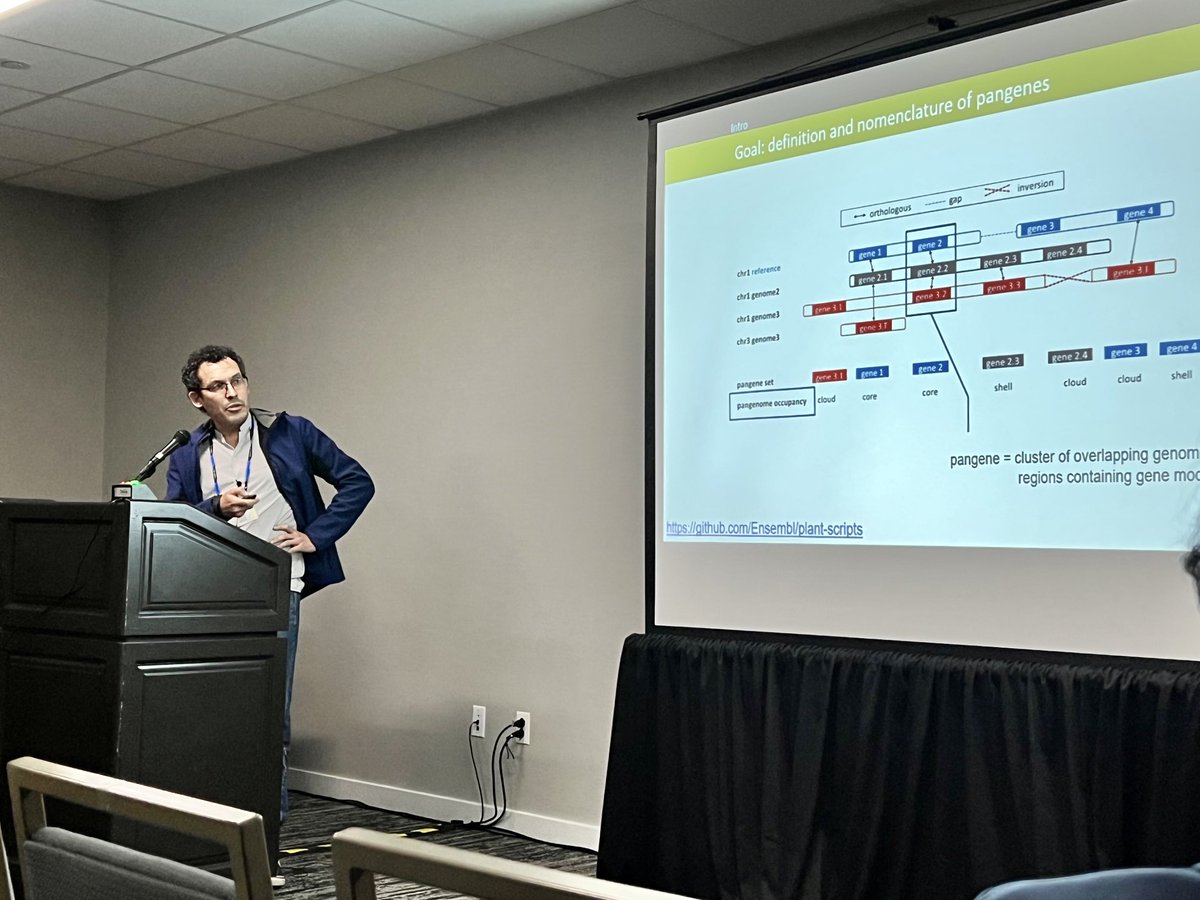Tuesday 17012023
Ian D Godwin, QAAFI, The
University of Queensland. While he introduces sorghum, he recommends the book https://drunkenbotanist.com, which can be used for drinks, food and chicken fodder. In Australia it
is grown in the driest area on the E. They are using gene editing to improve it
and require high quality genomic resources, such as https://www.nature.com/articles/s41477-021-00925-x . They are particularly interested
in high resolution PAV maps, as PAV is a main driver of diversity in this crop.
Also they use a non-reference assembly for their work, although transformation
still needs to be optimized. They have
selected their own promoters that also work well in barley and maize. They are
using these to optimize may trais, mostly plant and root architecture, but also
starch composition, which is naturally in a tight protein matrix that make it
undigestible (https://onlinelibrary.wiley.com/doi/full/10.1111/pbi.13284). The plants have to be tested in
the field, root reach the bottom of a pot in 10 days. The obtained lies with
increased protein and larger grains. They have also tested them for poultry
feeding, and observed that digestible, high protein content reduces the amount
of soy-based fodder required by chicken. They further improved protein digestability
by knocking out gamm-kapharin. He mentions that a VRN1 homolog in Sorghum controls root angle. In
questions he says they are now introgressing their edited genes in parental
lines used for Sorghum hybrids.
Viviane Slon, Tel Aviv
University. She extracts ancient DNA from sediments. Previous work have
extracted plant and animal DNA 400K yr old (permafrost). Such experiments allow
to find out first/last appearance dates in sediments, which can be correlated
to past biodiversity, history, climate change and human activity. A few weeks
ago researchers have been able to go back 2M yr in Greenland. About 90% of the
successfully extract DNA has no BLASTN hits. To improve yield they use
mammalian mtDNA capture. What does differentiate ancient DNA from modern? It is
shorter, C in single-stranded ends deaminate -> T (this is actually as a
sanity check by counting nt substitution pero position). They are now able to
extract hominid mtDNA from the soil even when there are no bones, as they have
shown in the Denisova cave (https://www.nature.com/articles/s41586-021-03675-0). They have also managed to extract
nuclear DNA in Galería de las estatuas, Atapuerca (https://www.science.org/doi/10.1126/science.abf1667) and distinguished two Neanthertal
populations. What next? Her lab is now developing methods to improve field
sampling, the wet lab and data analyses. With this toolbox we should be able to
fill the gaps in the biodiversity history, particularly for plants. With high
density sampling in sediment transects we should be able to estimate changes in
allele frequencies with help from coalescent theory.
Samuel P. Hazen, University
of Massachusetts Amherst. Talks about their experiments to find TFs that might
be controlling cell wall thickening in Brachupodium
distachyon., such as the bZIP named SWIZ. This is one among other TFS that
are thigmotropic, relocating and locally expressing to the nucleous when the
plant is touched/perturbed (this depends on calmodulin and Ca being released).
Expression lasts about 1h. They find
that 7-9K genes are differentially expressed (DE) upon touching the plants and
they have also discovered a couple of DNA motifs for SWIZ using ATAC-Seq
analysis. They have also done de novo discovery of motifs upstream of DE genes.
Adding external GA hormone represses movement to the nucleous. There’s a
preprint at https://www.biorxiv.org/content/10.1101/2021.02.03.429573v2.abstract
Melissa Bredow, Department
of Plant Pathology and Microbiology, Iowa State University. Frost is still an
important stress for crops despite global warming. Freeze damage starts by seed
ice crystal that end up piercing cell membranes. Gradual expose to cold
expressed ice-binding proteins (IBP) that protect membranes upon freeze. She
uses brachy as model to study the protection provided by IBPs. There are seven
IBPs in B. distachyon (BdIRI1-7),
none in A. thaliana. These protein
are only stable < 4ºC (disordered otherwise) and theire folds are different
across species. Apparently is not just cold what matters, but also bacterial
(Xanthomonas, Pseudomonas sp) ice nucleation proteins that favour freeze and
membrane destruction. Their current modela is that BdIRI proteins actually bind
to bacterial nucleation proteins to inhibit their function.
Todd Blevins, Centre
national de la recherche scientifique, University of Strasbourg. Studies the
role of RNA polymerase IV in brachy, which silence transposons by transcribing
non-coding RNAs that drive AGO-based silencing, as reviewed in https://www.annualreviews.org/doi/abs/10.1146/annurev-arplant-093020-035446. Mutants of these genes (nrpd1)
have reduced leaf elongation via regulation of cell production and via cell
cycle exit. In addition, mutation causes higher expression of some genes,
including bZIP TFs, which are silenced in the wild type. These have
differentially methylated promoters. This varies across ecotyopes and depends
on the presence/absence of a TE. They have screened methylated sequences with
Illumina and Nanopore and found very comparable results, although ONT is
superior when it comes to check individual TEs, as Illumina reads multimap.
Birkett Clay, USDA-ARS.
Talks about integrating into https://breedbase.org Practical Haplotype Graphs built
from exome data for wheat and barley. He uses code at https://github.com/TriticeaeToolbox/PHGv2 and imputation protocols at https://wheat.triticeaetoolbox.org/static_content/files/imputation.html. Imputation accuracy at the PHG in
barley is > 93% if #markers > 2000. Details and converted VCF files are
available at https://files.triticeaetoolbox.org . They display the resulting PHG
with JBrowse (https://triticeaetoolbox.org/jbrowse). The PHG is built on a single
reference genome, so you might need to select the appropriate reference to
optimize imputation (or build a mosaic reference). Creating the PHG is
computationally intensive, but the imputation is quite fast.
Karen A Sanguinet, Washington
State University. She talks about buzz mutants that affect root biomass and
hair formation in brachy. The A. thaliana ortholog rescue the mutant phenotype.
She saw that BUZZ expression responds to N availability, although primary root
growth is not N-responsive. It is expressed in the root epidermis.
Kapeel Chougule, Cold
Spring Harbor Laboratory. Presents (PanOryza) efforts to consistently annotate
gene models in the rice pangenome. Canonical isoforms are called with TRaCE (https://academic.oup.com/bioinformatics/article/38/1/261/6326792). At Gramene they have rice subsite
and plan to build pan-gene indexes.
Andrew Olson, Cold Spring
Harbor Laboratory. After a little history of the Gramene project (2022), he
presents the pangenome sites (2021-22), which currently represent the larger
bulk of new genes being added to Gramene (maize, rice, Vitis and Sorghum). He goes to summarize all the
tasks involved in setting up and maintaining the sites, the import of data from
Ensembl Plants (https://plants.ensembl.org) and Expression Atlas, and mentions
they are now following the standards agreed at https://data.nal.usda.gov/ag-data-commons-collection-development-policy.
Sushma Naithani, Dept. of
Botany and Plant Pathology, Oregon State University. She presents her work on
curating plant reactome pathways using omic datasets (https://plantreactome.gramene.org). These pathways are linked to genes in
Ensembl Plants and Gramene, which in turn often link to gene expression data.
The curation protocols are illustrated at https://peerj.com/articles/11052. Currently they 126 species and 326 pathways,
which have been project to 39K genes.
My turn. I presented our recent work "Building pangene sets from plant genome alignments confirms presence-absence variation", from the PanOryza project. The preprint can be read at https://www.biorxiv.org/content/10.1101/2023.01.03.520531v1 and code and documentation obtained here: https://github.com/Ensembl/plant-scripts/tree/master/pangenes.

[Source: Agata]
Jonathan Cahn, HHMI-Cold
Spring Harbor Laboratory. Talks about regulatory elements in maize inferred
from diverse omics datasets (ie ChIP-seq, H3K4-me1) as part of http://www.maizecode.org, which follows ENCODE guidelines.
Raw data can be downloaded, I cannot see the DNA motifs though. Superenhancers
are delimited by methylated areas and enriched in H3K27ac and accumulate
binding sites.The results of this project are described at https://www.frontiersin.org/articles/10.3389/fpls.2020.00289/full. Shows really nice plots made with https://cran.r-project.org/web/packages/ggalluvial
Sarah Dyer, EMBL-EBI. Talks
summarizes the current status of the wheat pangenome at Ensembl Plants: https://plants.ensembl.org/Triticum_aestivum/Info/Strains?db=core. The main addition since last time
I checked is that now wheat genes have a cultivar-based Compara section, where
you can see orthology to genes in other pangenome wheats, ie: https://plants.ensembl.org/Triticum_aestivum/Gene/Strain_Compara_Tree?g=TraesCS3D02G273600;r=3D:379535906-379539827
Josh Clevenger, HudsonAlpha Institute for
Biotechnology. https://www.hudsonalpha.org/khufudata/plant-improvement
On Twitter I heard about a talk I missed by Katie Jenike were she presented Panagram, K-mer based software for alignment-free visualization & analysis of pan-genomes. There’s code (https://github.com/kjenike/panagram) and even slideas at https://twitter.com/mike_schatz/status/1615440857980899328

